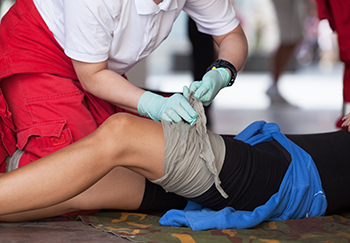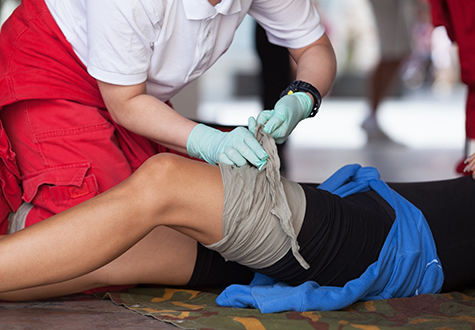
Lately, the news seems full of never-ending mass-casualty events. In the aftermath of these events, we often hear people say “we never thought something like this would happen here.” We never do know where these events will happen, but that doesn’t mean we are helpless to prevent loss of life when they do.
The National Bleeding Control Initiative
According to Liz Cochran, an injury prevention coordinator at UVA, that was the idea behind the Stop the Bleed campaign, a national initiative that began in 2015. The goal is to train the U.S. public on bleeding control in order to reduce deaths in mass-casualty events.
The Trauma Program at UVA’s Level I Trauma Center is leading a region-wide movement to promote bleeding control courses as well as instructor training.
“The goal is for the bleeding control course to become a national training standard. It’s already being referred to as ‘the next CPR.’ The course information is very simple; anyone, regardless of age or background, can become trained,” Cochran says. “People feel helpless seeing these events on the news, and want to know what they can do to help. Becoming trained in these lifesaving skills is such an important step towards personal and community preparedness should such an event occur.”
Learn More about Bleeding Control
Download the free Stop The Bleed booklet and register for a course.
It can take just a few minutes for someone to bleed to death if bleeding isn’t addressed, and in many cases, it can take at least a few minutes for first responders like police and EMTs to arrive on the scene. That’s when bystanders can literally be the difference between life and death — if they know the basic steps of controlling bleeding.
Basic Steps of Bleeding Control
- Call 911 or tell someone to call 911.
- Check for safety — ensure your own safety before offering help.
- Wear gloves, if available.
- Find the source of the bleeding. Open or remove the victim’s clothing if necessary.
- Apply direct pressure to the wound. Cover the wound with a clean cloth and apply as much pressure as you can, using both hands.
- Continue constant pressure until medical responders arrive and take over.
Finding a Local Bleeding Control Course
Bleeding control classes are being offered for free nationwide and are targeted towards typical civilians – people with little to no medical training. The goal of the course is to teach participants how to provide immediate, frontline aid in an emergency until first responders are able to take over. The courses are just 90 minutes long. The first half is instructional, and the second half is hands-on. Participants learn how to correctly apply pressure, pack a wound and even use a tourniquet.
There are several bleeding control classes coming up in Charlottesville and Richmond, and more classes are being added to the schedule. Both upcoming courses are free and open to the public, but space is limited. You must register in advance to reserve a spot.
For registration information and upcoming classes, visit BleedingControl.org.
